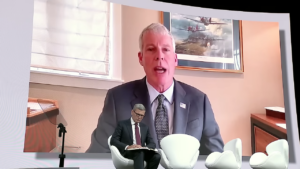The Australian Energy Market Commission (AEMC) announced last week that it is delaying the decision on a rule change request on the ‘financeability’ of transmission projects, submitted by the Energy Networks Australia (ENA), association of regulated Transmission Network Service Providers (TNSP).
The rule change would fundamentally change the way the risk of major infrastructure projects are managed, placing the burden of risk on consumers rather than on the monopoly transmission network businesses and their investors. Ostensibly, the transmission networks say this transfer of risk is necessary to protect their credit ratings.
The AEMC has already rejected a similar requests in 2021, from Transgrid in NSW and Electranet in South Australia. The AEMC’s primary reason for rejecting previous attempts to change the rules was that it would have a negative impact on consumers, increasing electricity bills.
In particular, the AEMC determined that TNSPs recovering their costs as incurred rather than as commissioned would mean that consumers were paying for transmission lines before they received the benefits of that new line in access to lower priced electricity.
As PIAC identified, the rule change would increase intergenerational inequities, with today’s customers paying for the benefits that only future customers will receive.
The AEMC also determined that it was inappropriate to place the risks of the project, including non-delivery, on consumers when only the TNSP has the ability to manage the risks.
Many industry stakeholders strenuously opposed this rule change, supporting the AEMC’s earlier decision. The current proposal has also attracted negative feedback, with over half of submissions being unsupportive of the ENA rule change.
If nothing has changed since April 2021 when the AEMC decided the approach from Transgrid and Electranet was inappropriate, why hasn’t it rejected this new rule change request on the same basis?
Most privately held companies, like the majority of the TNSPs, seek the assistance of their investors when seeking to expand the business. And the TNSPs asset base is expected to double over the coming decade, netting their owners and investors significant dividends. But still the TNSPs insist help is needed to build the new grid, while expecting Australians to fork over more money.
The request for specific financeability rules to protect the credit rating of the monopoly regulated TNSPs undertaking investment in new transmission strongly suggests that these private sector companies are not financially capable of underpinning Australia’s transition to a low carbon electricity system.
As the Australian Energy Council (AEC) said in its submission, “the financing challenges TNSPs face on large investments is not unique to them” and they are “sceptical as to whether regulated network service providers ability to raise capital is impacted in a manner that requires a regulatory response.”
Either the TNSPs are financially capable of delivering the new transmission or not. If they are capable, then it suggests that the TNSPs are favouring profits and their investors over their customers.
If they are not capable and require financial support through a concessional financing scheme (another rule change), or a rule change to encourage their owners to invest in new transmission, then we need to explore other ways of delivering the transmission lines Australia needs to achieve emissions reductions.
Call for a new approach
It would appear that the regulated monopoly TNSPs are not in a sufficiently robust financial position to undertake the transformational investment needed to provide new transmission.
Australia’s TNSPs in the National Electricity Market (NEM) are small compared to transmission companies globally. A number of these international companies are already established and operating in Australia having tendered for the Renewable Energy Zone transmission projects in the NSW.
Some of these experienced international companies have an asset bases that is equivalent to the entire transmission asset base of entire National electricity market, but only have a annual revenue equivalent to a single Australian TNSP, suggesting more efficient operations.
An option to resolve both the delays in building new transmission lines and any financeability issues is to open up Australia’s regulated approach to transmission to competition, as has been adopted in Victoria.
This would mean these international operators could tender for projects, bringing experience, economies of scale and access to robust supply chains to our market that could reduce costs and they wouldn’t need financeability support, since their investors operate on a global scale and understand the opportunity afforded by Australia’s clean energy transition.
The AEC suggests that “contestability would relieve incumbent TNSPs of these apparently challenging responsibilities to finance and build ISP projects by allowing others to do so. Another valuable economic outcome of contestability is that it would yield true price discovery.”
PIAC also highlights that “where potential financeability issues might threaten the viability of actionable Integrated System Plan (ISP) projects, these should be managed firstly by making the investments more contestable,” rather than placing additional cost and risk burdens on consumers.
A more radical option would be to allow the financeability rule change and any support through federally-provided concessional finance to apply only to transmission projects which have been subject to a competitive process to select the developer, the best route and the best price.
Using competition for new transmission would give Australians greater confidence that the investment in the clean energy transition is what is actually necessary, rather than allowing the regulated TNSPs to pad out the costs to increase their profit adding or, as Business NSW says, compensating for the financial shortcomings of particular incumbent TNSPs.
Australia needs to get on with delivering the transmission on which new clean renewable generation and batteries, are dependent.
If the regulated monopoly TNSPs are unwilling or unable to invest in the new transmission lines then the Australian transmission market should be opened to competition to allow experienced entities to deliver the infrastructure that will allow Australia to become the clean energy superpower that it can be.
Stephanie Bashir is CEO of Nexa Advisory, and an energy specialist.










